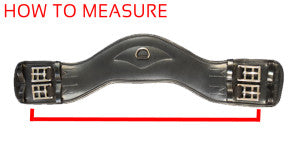To find your size measure your girth buckle end to buckle end.
Choose the girth to suit your saddle
The longer girth, the All purpose or Jump girth, this is designed to fit saddles with the girth straps buckling up under the saddle flap.
The spacing suggestion does not apply to any saddle that uses a long (AP/Jump) girth.
The shorter girth or Dressage girth will fit saddles that have longer girth straps with the girth buckling up beside the lower leg.
For dressage, we suggest a gap of 4 - 6 inches from the bottom of the flap to the end of the girth. That gap can be larger on monoflap jump saddles.
The western cinch will fit your western saddle using your heart girth strap.
For the Shoulder Relief Cinch on Western saddles we suggest a gap of approximately 8 inches from the end of the cinch to the rigging.
All of our girths & cinches measure true to size buckle-end to buckle-end.
For dressage, we suggest a gap of 4 - 6 inches from the bottom of the flap to the end of the girth. That gap can be larger on monoflap jump saddles.
The spacing suggestion does not apply to any saddle that uses a long (AP/Jump) girth.
For the Shoulder Relief Cinch on Western saddles we suggest a gap of approximately 8 inches from the end of the cinch to the rigging.

Measure from buckle end to buckle end to find the correct size for your saddle



Additional Considerations
- What is the ideal girth length? For dressage/monoflap jump girths we recommend the girth be 4-6 inches from the bottom of the saddle flap. This will keep the buckles above the elbow, allow for greater pressure distribution, and prevent the edge of the girth from resting on the horse’s pectoral muscles.
- Does every horse need the Shoulder Relief Girth? No, some horses are lucky enough to have the conformation perfectly shaped for saddle fit. However, many horses do need it, and sadly there are way more horses that feel the pain of interference from the saddle than you might imagine. And as horses are more frequently bred to be big movers, the need for shoulder freedom becomes more and more of a real issue.
- What if I have a perfectly fit custom saddle? First off, congratulations! Second, if your horse exhibits any of the above conformation characteristics then you (and he) could benefit from the Shoulder Relief Girth in a big way. No matter how well a saddle fits, if it is being pulled into the shoulders by “external forces” then it could cause an issue that would benefit from the proper girth.
***GIRTHS ARE MEASURED BUCKLE-END TO BUCKLE-END***
The Shoulder Relief Girth actually changes the position and angle of the billets to prevent the saddle from interfering with the shoulder.The center of the girth is set forward to sit in the horse’s natural girth groove. While the sides of the girth are cut back to meet the billets 2 inches behind where the horse’s natural girth groove lies. This brings the billets from angling forward, to becoming perpendicular to the ground (in the case of a forward girth groove horse), which reduces the saddle’s tendency to be pulled forward into the shoulders. With horses that have shoulder interference without angled billets, it simply moves the billets back to keep the saddle farther away from the shoulders.
The secondary benefit to this shape, is that it is cutback at the elbows. This gives more room for elbow movement as well, and prevents galls in the elbow area.
